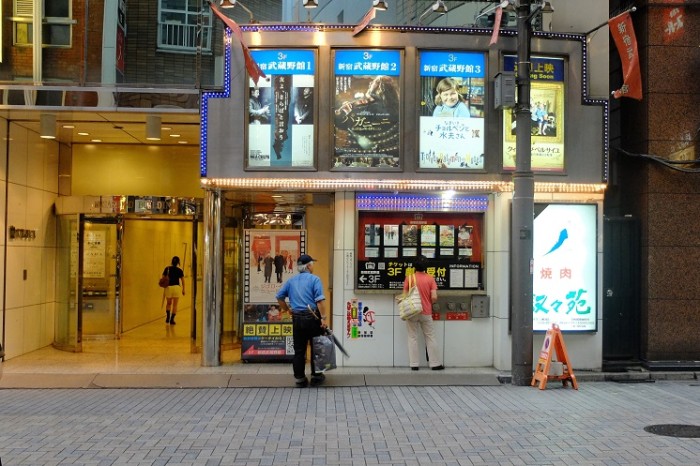Cinema Travels: Japan
Lugemisaeg 6 minIn Cinema Travels you can read about the filmscapes far far away. Why does film industry in Japan need Godzilla who could push the reset button? Keep on reading, and you’ll find out.

Seemingly, cinema of Japan couldn’t do any better: more and more domestic films are produced, while the blockbusters made in the studio of the the grand old man Hayao Miyazaki’s Ghibili break ever-increasing audience and box office records. However, the earthquake that hit this insular state quite unexpectedly three years ago and lead to Japan’s wider social separation from the world, has also left a bitter mark on the more than a century old Japanese cinema culture. Today’s Japanese film art twirls in two realities: commercial films made for masses as opposed to marginal author films that are slowly fading away.
Some of the stubborn cinema-puritans and film researchers have dated the death of Japanese film to 1960’s, claiming that besides one or two shining stars, like Nagisa Oshima (Merry Christmas, Mr. Lawrence, Taboo), nothing remarkable has happened. It’s by no doubt too early to fully agree with this claim, but it carries some bits of truth. Television reached wider audiences with the Olympic Games that were held in Tōkyō and dethroned cinema at a blow, bringing many of the biggest studios under the hammer. One of those studios was Nikkatsu whose special programme was shown at Estonian Black Nights Film Festival (PÖFF) a few years ago. In order to come out from a difficult financial situation, these studios had no other option than to produce low-budget genre films, full of sex and violence and films based on popular comics or anime series which were meant for masses and had been approved by the watchful eyes of advertising companies. The consequences of this burbly commercialisation had the hardest hit on author films and art house cinemas, which were pushed to evanescence one by one. Only a handful of them remained active after the 90s economic boom.
All this means that foreigners, who are not familiar with the local film history, can be quite shocked when they get the first touch of Tōkyō’s cinema life anno 2014. You only need your fingers to count those cinemas in one of the world’s biggest metropolises that show foreign films (don’t even mention the English subtitles). It’s even harder to find places that show local art house films or independent films. Lone radicals or visionaries, like mini-cinemas Eurospace and Uplink located at the Shibuya city district, have become sort of shrines of alternative culture – shrines to where the general public usually cannot find their way.
Cinema is dead to young audiences who have grown up with reality-shows and commercial films made for an average person… Young audiences are only drawn to cinema when they can see another Miyazaki’s superhit, movies based on well-known comics, a telenovela’s cinema version, or a Hollywood blockbuster. Everything else that fails to fit in these frames, is seen as henna (strange, odd, kinky) or speciality of otakus (nerds, geeks) by the 20-something Japanese who should be a potential and ordinary visitor of the cinema. This quite controversial statement is confirmed by the numbers: if around 400 foreign films are shown in Japan in a year, 70% of those are produced in Hollywood. Korea and France, which follow Hollywood in this table, cannot compete with the hegemony of commercial cinema, although both of them release 20-30 films a year in Japan. This often leaves filmmakers and critics in a situation where they have nothing else to do than to admit that there’s some kind of a self-made cultural isolation in Japan.
Local film industry should mainly accuse itself for the downfall of film as a popular, yet educating form of entertainment. The studio trio Toho, Toei and Shochiku, who have been doing whatever they want for decades (as there’s no regulations) and who have a monopoly both in the production and the distribution of films, haven’t been able to keep abreast of the times despite the demand. They’ve been using quite old-fashioned and audience-repellent ways to fight with the piracy and decreasing interest. It’s clear that one of the world’s most expensive tickets (Ticket in IMAX costs up to 25 € in Tōkyō, regular ticket up to 20 €) and expelling a student who has downloaded some films is not an effective nor innovative business strategy in the 21st century. This is why going to cinema in Japan is not for young people, but rather for middle-aged or pensioner film gourmands who can afford a regular 25 € expenditure.
Taking into account this rather morbid backstory, we still have to state that this little group of Japanese cinema fans have remained the world’s best and most loyal audience. Be it in a miniature art house cinema in Shinjuku, like Musashino, which has a screen no bigger than a TV of a rich businessman, or in the multiplex 109 Cinema at the Kanagawa’s shopping centre, still – watching a film is and remains a solemn ritual for the Japanese fans.
This exceptional rituality can be experienced over and over again, like now, when I’m going to see the remake of the most famous monster in Japanese cinema history – Godzilla. The ceremony has been polished to details. Bell that marks the beginning of the film, the request to follow the rules in the public room (although the fear that somebody’s going to throw popcorn at you or starts to send text messages is absolutely nonsense), and then 2 hours and 3 minutes of soulful participation in the depredations of the most famous monster in Japanese cultural history. The moment, when Godzilla (with the help of IMAX sound system) emits the sounds that has etched indelibly in the film history, leaves the audience in catharsis. Godzilla is not only a radioactive megasaur from the distant past, it is also a reborn kami-sama – one of the millions of Japanese wild spirits, that first bring chaos and then offer protection, being kowai (terrifying) and kawaii (cute) at the same time. This quite religious conversance lasts until the end of the film. Credits. This silence could be cut with a knife. The lights are turned on and people leave in silence, which is a sign of great appreciation in here.
Japanese are a die-hard nation that keeps on getting on its feet, even after thousands of years of natural cataclysms that still occur. When I glance over the people leaving the cinema, something tells me that the author films and film culture overall are going to get up again sooner or later. Maybe they only need Godzilla who could push the reset button on the local film industry, and an audience who’s fully committed to the art of film. Both of them can be found in Japan.
